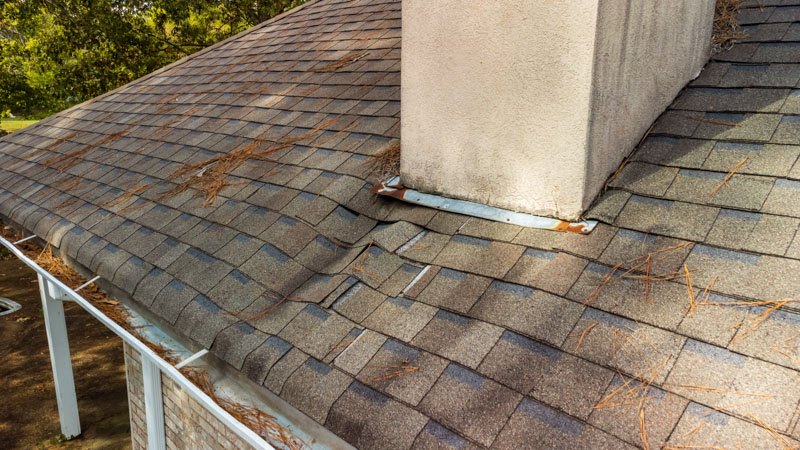Roof leaks are capable of causing extremely expensive damage throughout a home. If you own a home, it’s essential to know how to spot roofs leaks as well as their most common causes. When a roof leak occurs, it may not be immediately noticeable, but it will continue causing damage as long as it remains unaddressed. The best strategy is to call a roofer as soon as you suspect a leak. If you do, here are the most common causes.
In This Article
Most Common Causes of Roof Leaks

Every homeowner should know the most common causes of roof leaks:
1. Cracked flashing. The flashing on your roof is a network of metal flashes designed to create a water-resistant barrier. When physical damage from hailstones, falling tree limbs, or flying debris manages to crack a piece of your roof’s flashing, this disrupts the integrity of the water barrier and can quickly lead to a roof leak. It is also possible for flashings to crack and cause leaks without physical damage due to corrosion. Roofers typically use tar to seal flashings, and the dried tar can corrode over time and allow water to seep below the flashings.
2. Broken shingles. A professionally installed asphalt shingle roof can provide great protection against leaks, but this level of protection won’t last forever. If shingles sustain damage, crack, or break over time, this can allow water to seep into the roof bed very easily. You can check for cracked shingles visually or you might notice pieces of broken shingles laying in your yard or around your gutter system’s downspouts. If you notice this issue, contact a reliable roofer as soon as possible before the broken shingles let water into your roof.
3. Improper roof valley sealing. The “valleys” of your roof are the places where two planes connect, typically forming a V shape. These areas require special sealing because they tend to experience the most water flow. If the valley sealing wasn’t properly installed or sustained damage in any way, this is one of the most vulnerable parts of your roof when it comes to water damage. An experienced roofer can carefully inspect valley sealing and reseal them if necessary.
4. Damaged roof vent seals. The vents on your roof allow excess moisture to escape your home, helping to keep it as comfortable as possible inside. If the seals around roof vents sustain damage, the areas surrounding the vents will likely show discoloration and allow water to leak into the roof bed. A roofer will need to remove the damaged rubber boot around the vent and install a new rubber boot under the shingles around the vent before sealing it with caulk and roofing nails.
5. Ice dams. An ice dam can form on a roof when the gutters do not function correctly or overfill with leaves and other debris. Ice dams form when ridges of ice meet the edge of a roof, preventing melting snow and water from washing off the roof. Over time, the melted water that collects around an ice dam will melt and refreeze, making the ice dam larger while also penetrating below the roof’s shingles. The repeated expansion and contraction will cause the shingles to separate and eventually allow water to leak inside the house.
6. Clogged gutters. Your home’s gutter system allows rainwater and snowmelt to wash off of your roof and away from your home. Over time, your gutters will fill with fallen leaves, twigs, and other debris that you must remove regularly. It’s also possible for granules from older asphalt shingles to collect inside the gutters. Overflowing gutters will cause rainwater to spill back onto the roof and onto the siding of the house, potentially leaking behind the siding and under roof shingles and causing water damage to the underlying structures.
7. Damaged chimneys. You may enjoy using your fireplace during the winter, but it’s vital to use it properly and contact experienced professional chimney service providers to make sure everything is in working order. When your chimney is damaged, it can easily allow water to leak into your home. The chimney may have mortar missing between some bricks or have a cracked seal at the roof level.
8. Excess moisture in the attic. Your attic needs a functional ventilation system to prevent water damage and mold growth from excess moisture. During the winter, the attic is effectively trapped between warm and cool temperatures, creating the ideal conditions for condensation to form. Sealing the attic effectively and ensuring proper ventilation are the only real ways to address high moisture levels in an attic.
9. Physical damage from walking on the roof. If a negligent roofer or homeowner traverses the roof carelessly, it’s possible to damage the flashing, shingles, or other structures of the roof that can lead to leaks. It’s best to leave roof repairs to professionals, so most homeowners should never walk on their roofs. If a roofer accidentally damages a roof while performing repairs or service, they can repair it easily and safely.
Conclusion
These are just the most common causes for roof leaks. The reality is that there are countless possible causes of roof leaks that can lead to expensive water damage. Vigilance and proper maintenance are the best defenses against water damage from roof leaks, and experienced roofers can help homeowners with inspections, preventative maintenance, and repairs as needed. Homeowners who have outdated asphalt shingle roofs and experience repeated leaks may want to consider the value of investing in upgrades to new metal roofs. A metal roof provides superior leak protection to even the most well-built asphalt shingle roofs.
